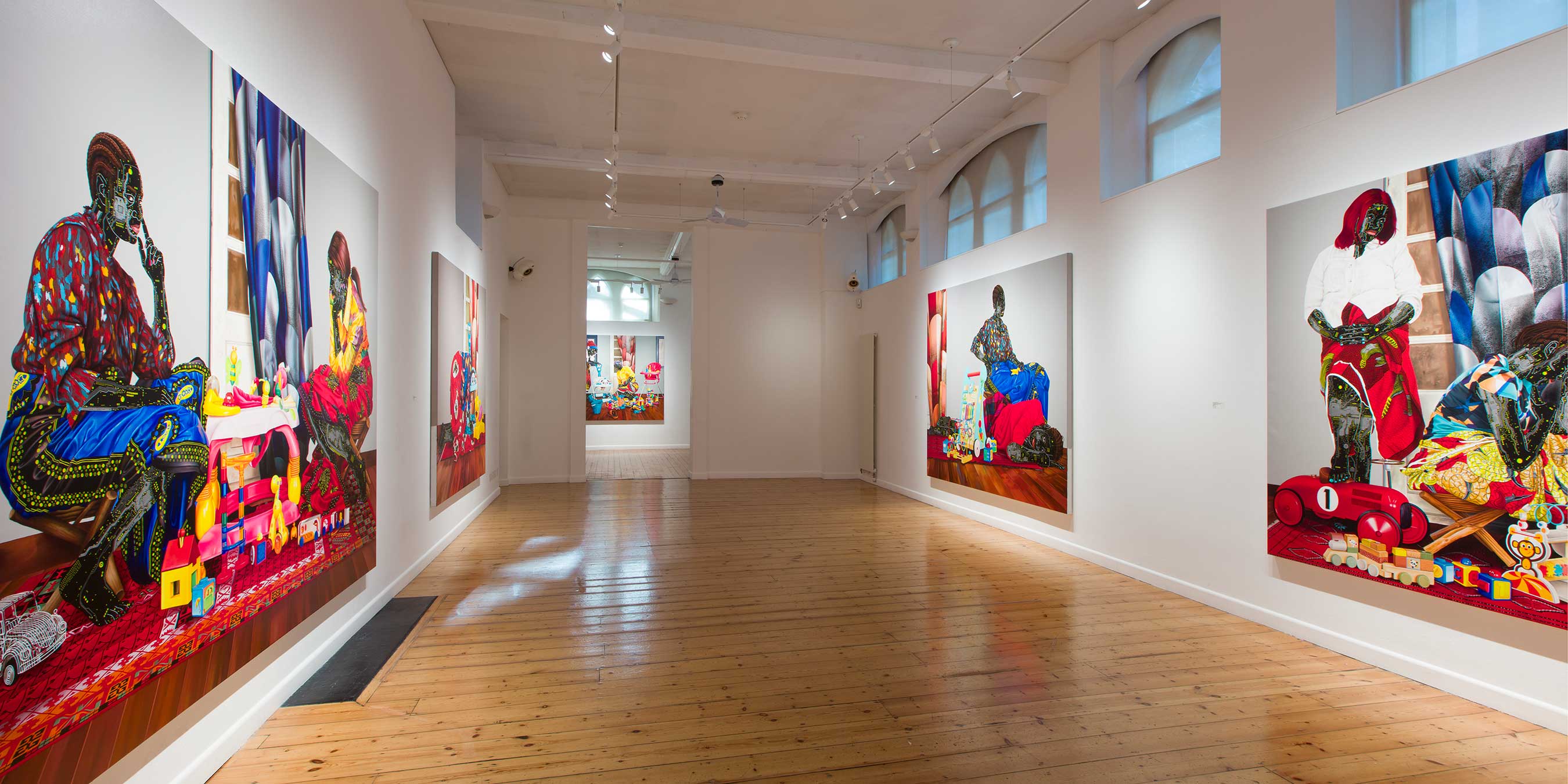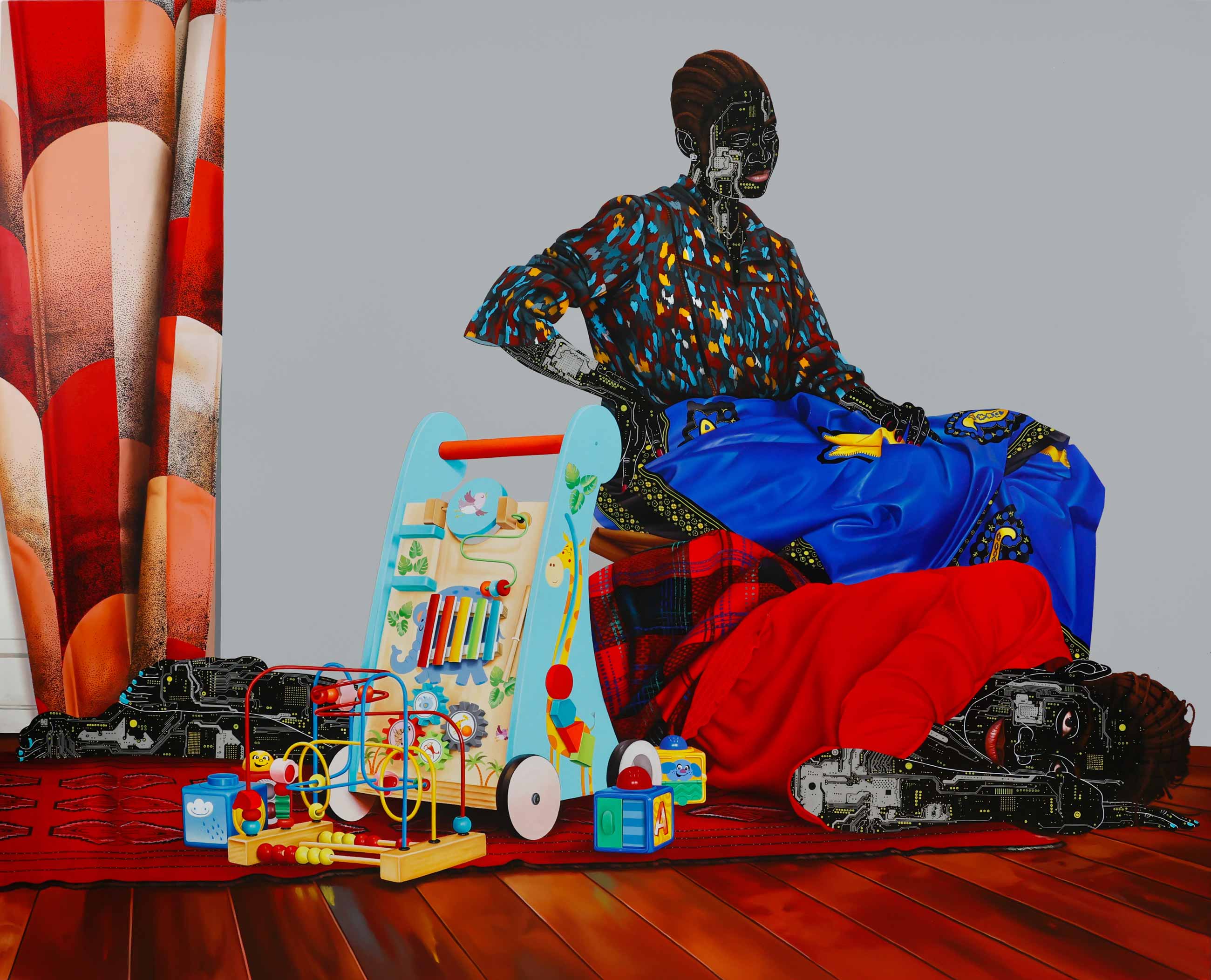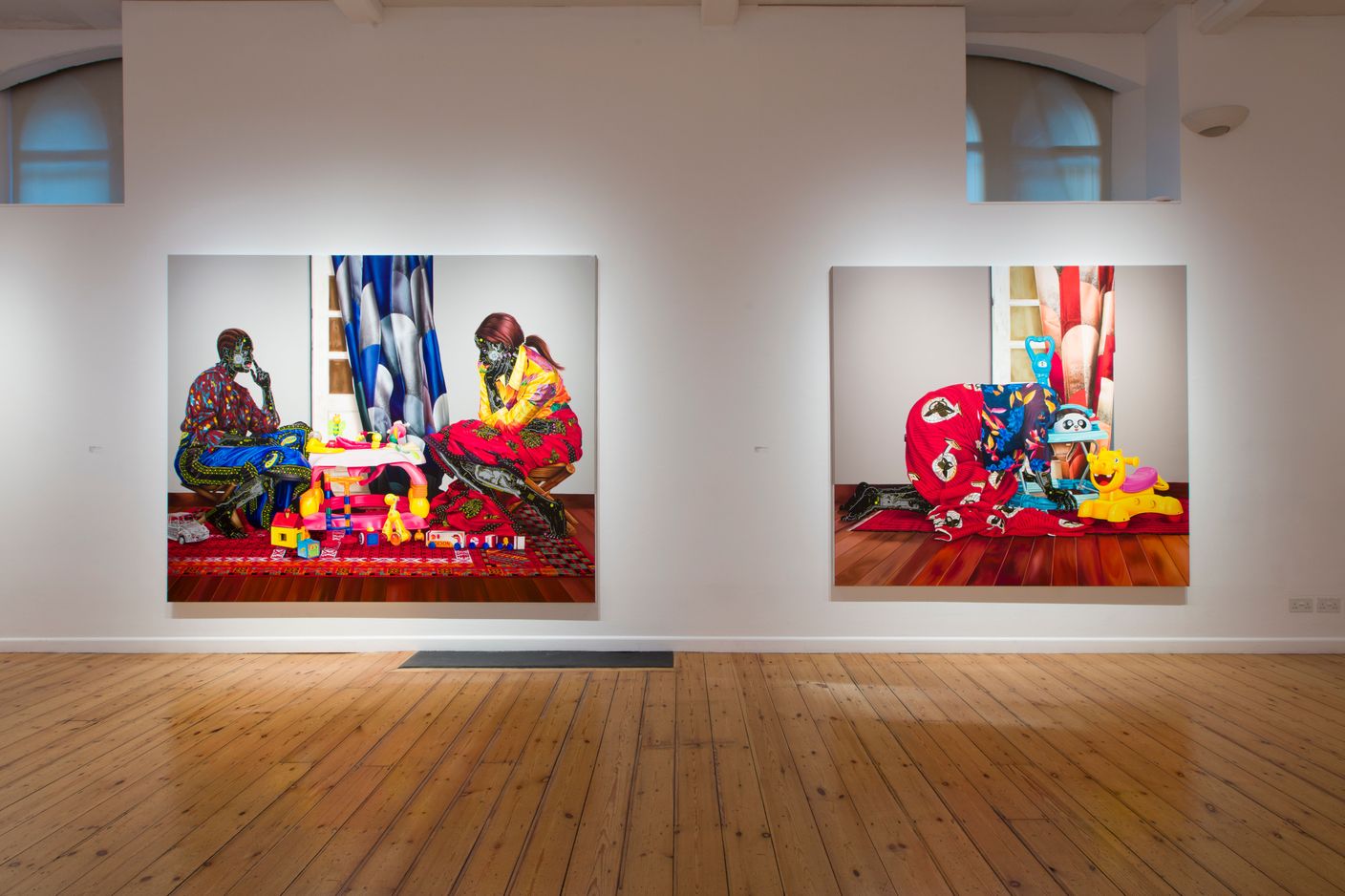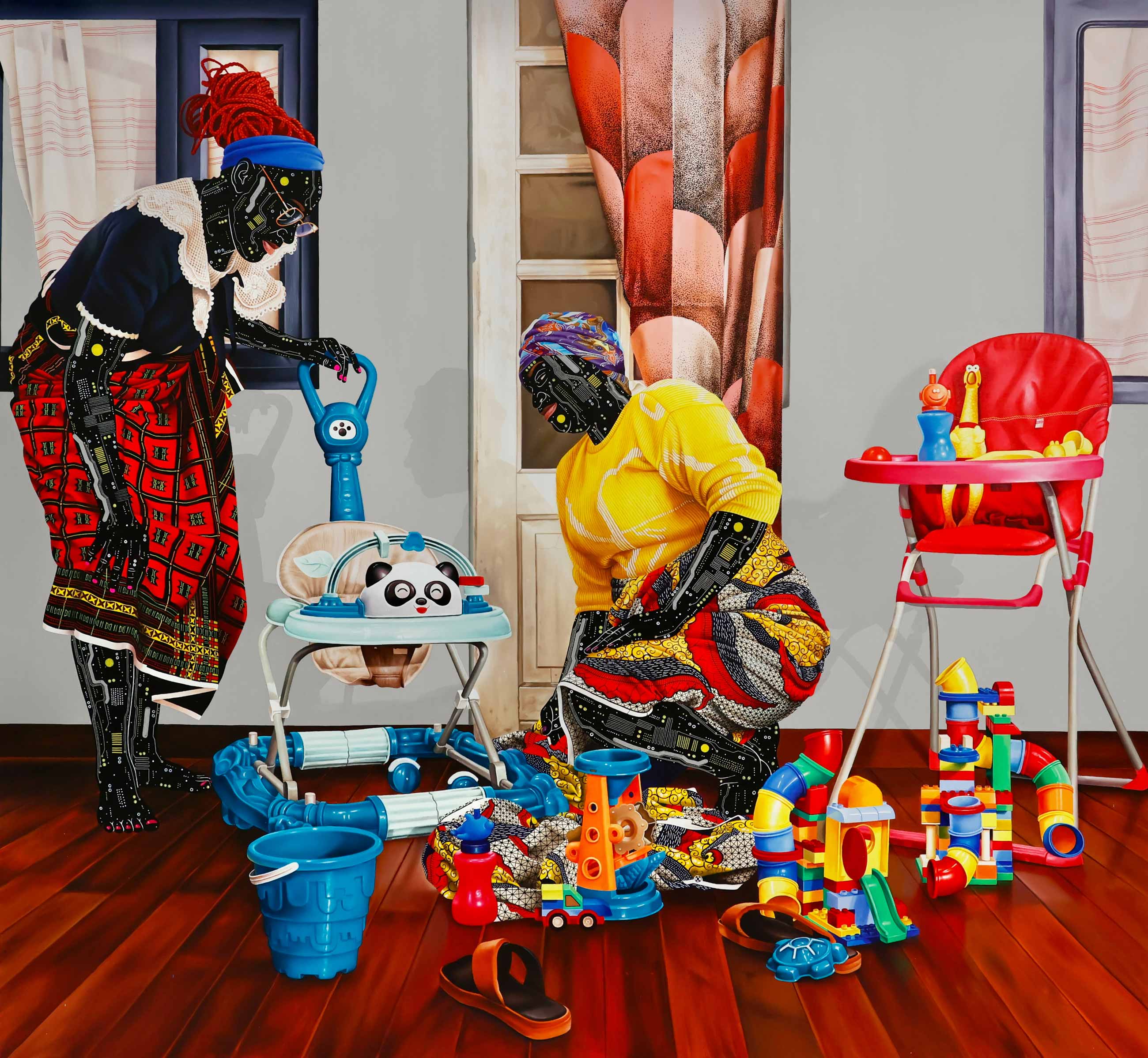Eddy Kamuanga Ilunga: Nature Morte
Eddy's fourth solo show with October Gallery, Nature Morte, ends January 25th 2025.
My first thought when taking in Eddy Kamuanga Ilunga's Nature Morte show at the October Gallery was: "Wow, this art is unreal." His paintings are vibrant and colourful, with computerised details drawing you closer to the canvas. Each piece tells a different story, commenting on the history of exploitation in the Democratic Republic of Congo (DRC) – the extraction of minerals by foreign powers, a cycle we are all complicit in through our need for technology. This exploitation continues to impact communities across the DRC, particularly in Katanga, where both of Eddy's parents are from.
We spoke to Eddy about the inspiration behind his exhibition,advice he has for young artists and how we can help address the ongoing crisis in the DRC. Here are his responses below:

What inspired you to create this exhibition/series of new works?
Something immediately obvious in my paintings, is the electronic circuit patterns etched into the skin of the figures portrayed. I began using this device over 15 years ago and there are many ideas underpinning it.
Simply speaking, I’m referring to black skin as a ‘space of exploitation.’
In my new series, Shadows of Lualaba, I’ve come right up to the present moment, where I’m talking about the serious impacts on local communities caused directly by the actions of multinational mining conglomerates from Europe and China. Essentially, many indigenous communities are not only being pushed off their inherited lands by invasive mining companies, but the contamination of their soils and water supplies by toxic spills and by poisonous dust clouds escaping from the mines is causing massive health problems throughout the entire region.
These problems are particularly serious in women and young girls, as infant mortalities, still-born foetuses and a frightening increase in birth defects and cancers are becoming the horrifying norm. In these new canvases, I was concerned to present these issues without being overly descriptive about specifics or particular circumstances. The figures portrayed in these paintings will certainly disappear if systematic exploitation of their lands, for not to mention abuse of their human rights, doesn’t’ stop soon—yet things only seem to worsen, year after year.

Which piece from this exhibition is your favourite and why?
This work, La vie et demie (Life and Half-Life), 2024, was a breakthrough piece which opened a path I could later follow in other works. All my paintings begin with photographs made in the studio with models—often friends or immediate family members—enacting various scenes we create together on a constructed stage-set. I spend a lot of time adjusting the figures’ poses and varying the angles, trying to align and capture all the elements in a single photograph. Only then can I put paint on canvas to realise that carefully composed image in my preferred medium, acrylic paints on canvas.
This one didn’t develop like that at all. After a long session in the studio, one of the models was tired, so we all took a break while she lay down to rest on the carpet. I’d just taken the SD card out of the camera to download the session’s photos when something in her pose caught my eye, so I quickly began to shoot again. The click of the shutter made her open her eyes and without moving a muscle she looked over towards the camera to see what was going on. That’s the origin of this particular image: a combination of physical exhaustion and absolutely focused attention. I couldn’t have scripted that, and this single shot was the unique result of hours of experimentation.
In the initial photo of this sequence her eyes are still closed: in everything that follows, her body has moved and the lines and shadows have altered. Since she was the only figure in the frame at the time, there was a large empty space above her, so I later added the sitting figure behind, to balance everything up. It always fascinates me that some works only come together after hours of careful experimentation, while others come and go in an instant. As an artist you have to be ready to seize both eventualities. The work also reminds me how dependent I am on the models who help create these tableaux with me. Some of them are artists in their own right and I rely heavily on their input and support.

How can we protect the environment and help address the crisis in the Democratic Republic of Congo?
That is a question we must ask ourselves over and over again. I think we all know that it's an absolute necessity to protect the environment within which we live. I'm not an expert on this subject, nor on the environmental challenges we are all facing, either in the immediate present or in some future that might arrive sooner than we think. For me as an artist, I choose to contemplate things that others consciously ignore, but that are still there in their unconscious. Like everyone else, I use a mobile phone, but I also know where it comes from and I’m trying to confront the glaring contradiction involved in making “clean green energy” using industrial mining processes that have nothing to do with “clean” or “green.” Lualaba province today has become a “sacrifice zone” and people are suffering and dying daily to ensure a “green future” for the western powers. By definition, that is a future that hasn’t understood its fundamental origins. I think we all need to believe in a future that gives hope to humanity as a whole. Ultimately, it comes down to respect for human beings—all human beings.

What advice would you give to young artists who are interested in pursuing a career in art?
I believe that anyone can become an artist. In fact, it’s quite possible that everyone is an artist who generates their own individual world. However, most people never realise that, or never spend much time developing those aspects of their creativity. The technical side of things can be learned by watching other artists, but that takes time. As a young boy, I became fascinated watching people painting posters that advertised western films, and I wanted to imitate them; to impress and excite people using colourful images. That just takes time and repeated practice.
But to those who are seriously interested in pursuing a career in the arts, I would say that, in my experience, what's most important is sincerity. When I say ‘sincerity,’ what I mean is that whatever you imagine and whatever you produce has to come from deep inside you. Whatever you think is really important must come from your own experiences, be rooted in your own life and be based entirely on the way you see the world. It is only when that sincerity becomes visible that an artist arrives at what can be called authenticity. The work of an authentic artist is such that no matter from where in the world another human being comes, they will be able to identify the lived realities expressed in that artist’s work, be it painting, sculpture, dance, music or performance.

What message do you hope for audiences to take away from this exhibition?
I think what's important for me is to stimulate the dialogues that open up between each individual spectator and these new paintings. These dialogues will depend on the lived experiences of each and every person who interprets my work in their own way. That’s the intersection point that most fascinates me. The work becomes a medium—I’d almost say a catalyst—that draws us together into meaningful dialogue. To understand how people can identify with my art, even without realising the specific details I’m attempting to filter through my work, the ‘message’ I was trying to transmit, continually surprises me.
To return again to my exhausted model: an art critic recently observed this figure’s similarity to the prone girl in Gaugin’s Nevermore, remarking that It was thought that she too had recently lost a child (perhaps Gaugin’s own). Having earlier explained the source of this particular figure, I know that nothing was further from my mind than a French colonial artist in Tahiti, and yet, I too gain insight from these overlapping associations. In the end, it’s this openness to interpretation that most interests me. Everyone is invited to interpret and ‘own’ them in their private individual way. I’d like my works to have at least as many meanings as there are people who encounter them and become drawn in by the questions they pose.